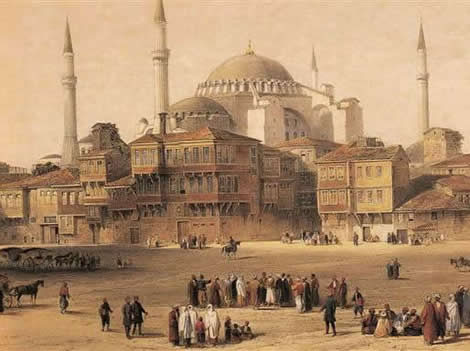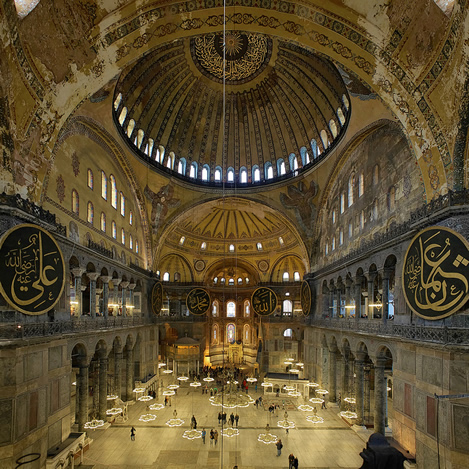 |
| Ancient Byzantine church, Hagia Sophia |
The cathedral church of Constantinople, built on the ruins of an earlier church, dates back to the fourth century c.e. hagia sophia in Greek means "holy wisdom", referring to the holy wisdom of God, a theological concept much discussed in religious traditions.
The original church was destroyed by fire in 532 during a massive riot against the government of Emperor Justinian I (527–565 c.e.). Justinian restored order and commanded the construction of Christendom’s then greatest church.
The plan was designed by architects Anthemios of Tralles and Isidore of Miletos and took, according to one source, two teams of 5,000 workers five years to complete. The magnificence of the church was apparent upon its consecration in 537, when Justinian reportedly declared, "O Solomon [the legendary builder of the Temple in Jerusalem], I have outdone thee!"
  |
The church is approximately 250 feet long, 230 feet wide, and sits beneath a dome 100 feet in diameter that reaches nearly 185 feet from the ground. The dome rests on four arches (themselves supported by four massive piers).
Beneath the dome are openings that let light in, creating an appearance that the dome rests on air, held up by heaven itself. The dome’s design was extremely bold and suffered as a result, collapsing in 558. The dome was repaired but was susceptible to damage by earthquakes in subsequent centuries.
Hagia Sophia radiated Orthodox Byzantine power and wealth. Its interior mesmerized onlookers with the sparkle of a ceiling covered in gold, a sanctuary adorned by 40,000 pounds of silver, glowing mosaics, and decorative marble, all of which proclaimed the glory of Byzantium.
 |
| Ottoman mosque, Aya Sofya (1852) |
For building this church, the memory of Emperor Justinian in the Byzantine mind was outdone only by that of Constantine the Great, who built Constantinople. A mosaic in the Hagia Sophia’s narthex depicts each emperor offering his monument to the Virgin Mary holding the Christ Child. Constantinople and Hagia Sophia came to epitomize Byzantium for the next millennium of Byzantine history.
As the church of the Orthodox Patriarch, Hagia Sophia served as the liturgical center of Constantinople and the Byzantine Empire. It also played a central role in the empire’s political life as the location where the patriarch crowned each new emperor.
It also played an essential part in imperial processions and the expression of Byzantine power to foreign ambassadors. The sight of the Hagia Sophia impressed visitors from Western Christendom, the Slavic lands, the Muslim world, and the various tribes of the north.
   |
When, in the 10th century, for example, Russian visitors sent by Vladimir of Kiev visited Constantinople, the emperor sent them to behold the worship in the cathedral (expecting them to be impressed).
In fact, they were so mesmerized by the experience, they declared that were uncertain whether they were in heaven or on earth. Vladimir and the Russians soon converted to Orthodox Christianity.
The cathedral remained the great monument of Orthodox Byzantium until 1453, when the Ottoman Turks conquered Constantinople under Sultan Mehmet II. The sultan converted it into a mosque, adding minarets. When the Ottoman Empire ended in the early 20th century, Turkish ruler Kemal Atatürk converted the building into a museum.
 |
| Inside (*just*) secular museum, Hagia Sophia |